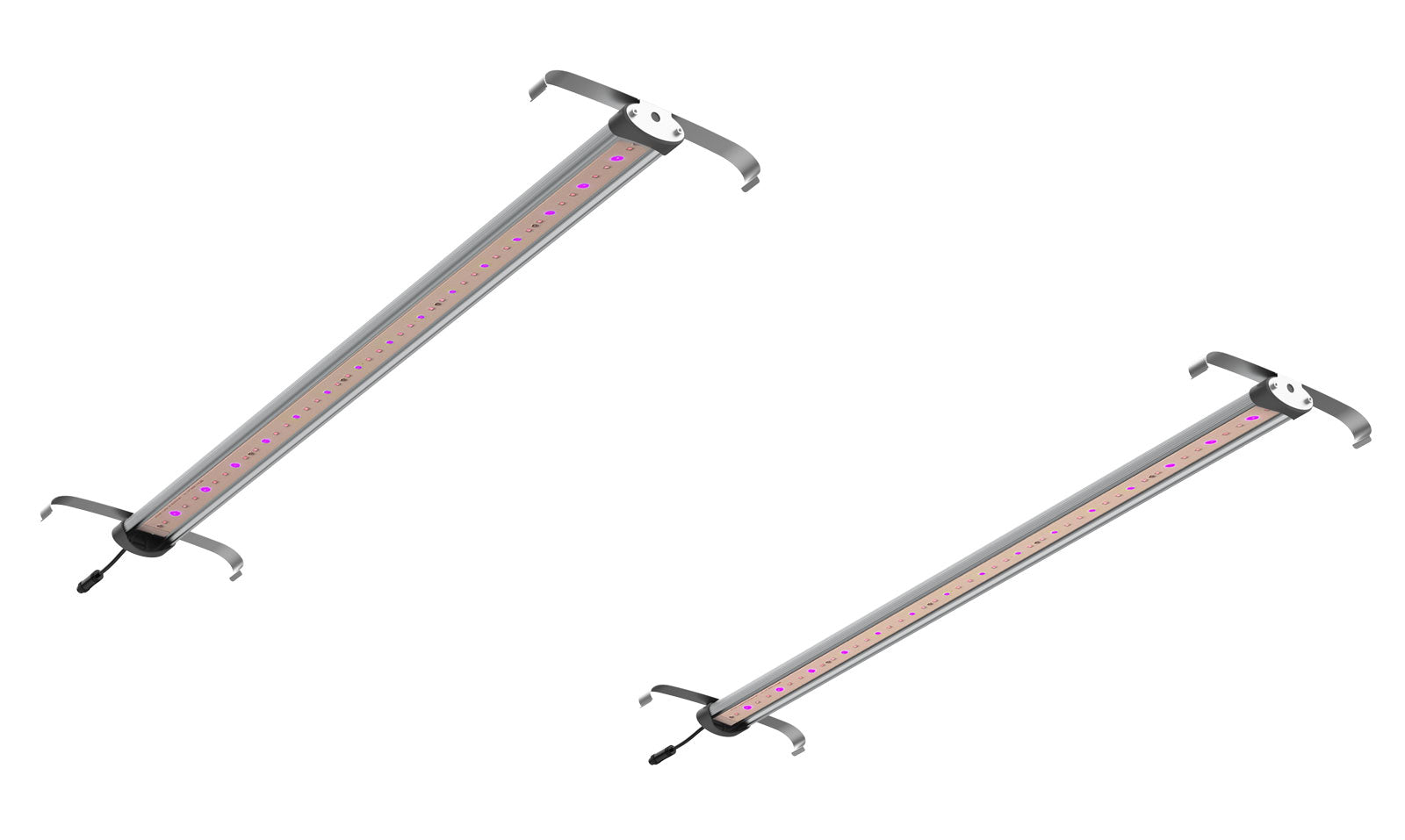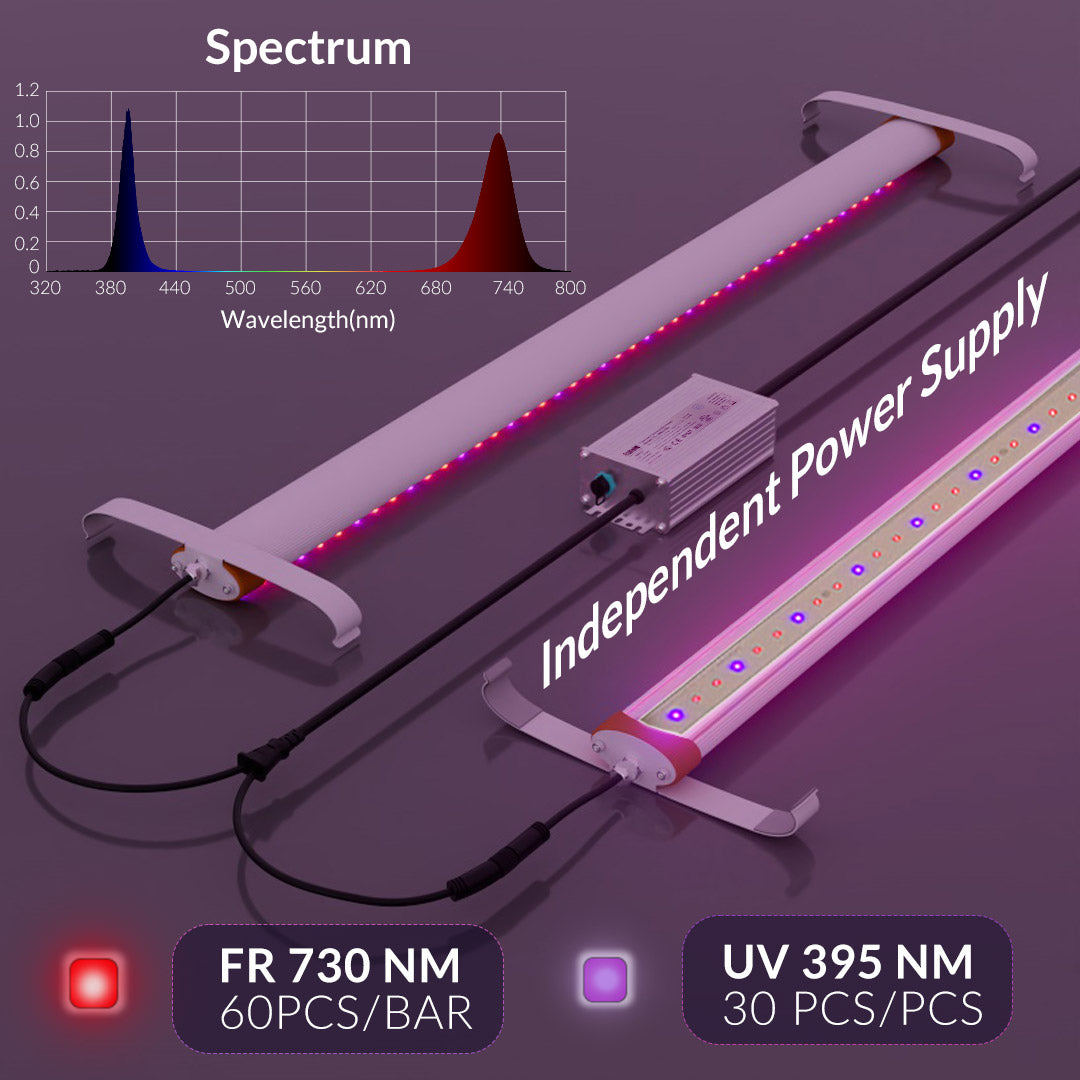UV Plant Light & UV Grow Light
Medicgrow's UV light for plants can enhance the potency and quality of your flowers. Our UV plant light is easy to install and control, and it optimizes plant growth with UV light, and Far Red light. Additionally, our UV grow light includes a dimming knob and supports wireless connections with the grow light controller, enabling controlling up to 200 UV light bulbs for plants. Let's delve into the details!


Medic Grow Spectrum X 780-880W Adjustable Full Spectrum UV and FR Commercial LED Grow Light for 5X5FT


UV + FR 4 ft Supplemental LED Grow Light Bar
FAQ about Plants UV Light
Q: What Do You Have in Your UV Grow Light?
A: Our advanced UV grow light setup features a full-spectrum grow light enhanced with 2x UV light bulbs for plants & IR Bars, delivering 100 watts of power. Here are the details for our plants UV light setup:
- Full-Spectrum Grow Light: Our UV grow light provides 2 switchable light spectrums that mimic natural sunlight, promoting both plant vegetative and flowering stages.
- Plants UV Light: Plants UV stimulates resin and essential oil production, enhancing strength and flavor.
- IR Light Bar: Our UV grow light with IR light bar supports the plant flowering process, promoting faster and more robust bloom development.
- Grow Light Controller: This allows tuning of UV grow light intensity and grow light schedule, ensuring your plants receive the perfect light at each growth stage.
This UV light for plants setup is ideal for creating optimal growing conditions, with a grow light controller that allows precise light intensity and schedule adjustments. Besides, plants UV ensures your plants thrive, leading to healthier growth and improved yields. Optimize Your Indoor Growth with our UV light for plants today!
Q: Do Full-Spectrum Lights Have Plants UV?
Yes, full-spectrum LED grow lights often include some level of ultraviolet light for growing plants. Besides, our full-spectrum lights are designed to mimic natural sunlight, equipped with light bars emitting plants' UV light. There are 2 types of plants UV light:
- UV-A Light (320-400 nm): This is the longest wavelength and the least harmful of the plants' UV light types. It can promote certain beneficial characteristics in plants, such as increased resin production in plants.
- UVB Light (280-320 nm): This type of plant's UV light is more intense and can be harmful in large doses, but small amounts of UVB light can stress the plant in beneficial ways, potentially increasing the production of certain compounds like flavonoids.
If you're growing plants and considering full-spectrum lights, it's good to check whether the light includes UV light for plants, as these plants' UV can positively affect the growth and quality of the plants. Notably, our Spectrum-Y and Spectrum-X UV grow lights have both IR and UV light for plants, enhancing the flavor and potency of your plants and maximizing your plant yields.
Q: Are UV Grow Lights Good for Plants?
A: UV grow lights can be beneficial for plants, but their effectiveness depends on the type of plant, the growth stage, and the specific goals of the grower. Here's how UV plant light can impact plants:
- Increased Production of Compounds: UV-B light in the UV grow light can stress plants, leading to increased plant production.
- Flavonoids and Scent compounds: Plants' UV light can enhance the production of flavonoids and scent compounds, compounds responsible for the aroma, flavor, and color of the plant.
- Improved Pest and Disease Resistance: Exposure to UV light for plants can increase a plant's resistance to certain pests and diseases by thickening the plant's outer layers or inducing the production of protective chemicals.
- Enhanced Plant Quality: Some growers believe that UV light for plants can improve the overall quality of the crop, making fruits, vegetables, and flowers more vibrant and flavorful.
In conclusion, using UV grow lights can enhance certain plants, by increasing the production of beneficial compounds such as flavonoids.
To optimize the benefits of UV light for indoor plants while minimizing potential damage, it's important to introduce UV grow light gradually using a grow light controller, focus UV grow light's use during late vegetative and flowering stages, and maintain a proper distance from the plants. This careful management helps maximize the positive effects of plants' UV light while protecting both the plants and the grower.
Q: Can UV Light for Plants Replace Sunlight?
A: UV light for plants cannot replace sunlight because it only represents a small portion of the light spectrum. However, our full-spectrum LED grow lights with UV lamps for plants can replace the sunlight.
Sunlight provides a full spectrum of light that plants need for photosynthesis, flowering, and other vital processes. For indoor growing, plants' UV light can be a valuable supplement, and it should be used alongside full-spectrum grow lights that mimic the balanced light conditions provided by natural sunlight.
Our UV grow light not only enhances certain traits of plants, but it also provides the necessary wavelengths, such as red and blue light, that are crucial for photosynthesis and overall plant growth.
Q: Can You Leave a UV Grow Light on All Night for Plants?
A: Leaving a UV grow light on all night can disrupt your plants' natural light cycles, which are essential for regulating growth, flowering, and rest. Continuous plants' UV exposure during the night can stress the plants, leading to problems like leaf burn, stunted growth, and even potential DNA damage.
For healthier plants, it's necessary to mimic natural day-night cycles by turning off UV light for indoor plants at night. Instead, use UV grow light strategically during the day, especially in the late vegetative and flowering stages, to boost traits like resin production.
Additionally, using a grow light timer to automate UV light for indoor plants schedules can help maintain consistent cycles, ensuring your plants receive the right amount of plants' UV light and darkness for optimal growth.
Q: How Long Can UV Plant Light Leave on Plants?
A: The duration for which UV lamps for plants should be left depends on the type of plant, its growth stage, and the intensity of the UV-growth light. Here's a general guideline:
1. Start with Short Exposures: When first introducing plants' UV light, start with short exposure times, such as 15 to 30 minutes per day. This allows the plants to gradually acclimate to the UV grow light without experiencing stress.
2. Gradual Increase: Gradually increase the plants' UV light exposure time as the plants adjust. For most plants, exposure can be extended to 2 to 4 hours per day. This is typically sufficient to stimulate beneficial effects, such as increased resin production in plants, without causing damage.
3. Growth Stage Considerations: During the vegetative stage, UV light for plants should be used sparingly, as excessive exposure can hinder growth. Start with minimal exposure and increase slightly as the plant matures.
Besides, UV grow light can be more beneficial during the flower, especially for some plants. During this stage, plants' UV light exposure can be extended to around 4 hours per day to enhance resin production.
Always monitor your plants for signs of stress, such as leaf burn, discoloration, or stunted growth. If you notice any negative effects, reduce the duration or intensity of the plants' UV light exposure, and use a grow tent kit to fix it.
Moreover, UVA and UVB light for plants should be used as a supplement to full-spectrum lighting, not as the primary light source. This ensures that the plants receive the necessary wavelengths for photosynthesis and growth while benefiting from the specific effects of plants' UV light.
Q: Can Plants Get Too Much Plants UV Light?
A: Plants can't receive too much plants' UV light, leading to issues like leaf burn, stunted growth, and reduced yields. Excessive UV grow light exposure can stress plants, causing them to prioritize survival over growth, which can diminish overall health and productivity. This stress can also lead to DNA damage, reducing the quality of flowers and fruits, especially in sensitive plants.
To avoid these problems, it's important to use UV light for indoor plants in moderation. Start with short plants' UV exposure times, gradually increasing to about 2 to 4 hours per day as the plants adjust. Maintain a safe distance between the UV lamp for plants to reduce intensity and regularly monitor for signs of stress, such as discoloration or curling leaves.
Using a combination of plants' UV light with full-spectrum grow lights, such as Medicgrow Spectrum-X and Spectrum-Y, ensures plants receive the balanced light they need for healthy growth while still benefiting from the specific advantages of UV plant light exposure.
Q: When Should Plants' UV Light Be Used During Flowering?
A: Using UV plant light during the flowering stage can be a game-changer for plants, boosting the production of scent compounds. To get the most out of these plants' UV without harming your plants, timing and duration are key.
Start introducing plants' UV light in the mid to late flowering stage, around the fourth or fifth week, when the plants are focusing on flower production. Begin with short exposure times of 15 to 30 minutes per day, gradually increasing to about 2 to 4 hours as your plants get used to the UV light.
Make sure to use UV light for indoor plants alongside your full-spectrum grow lights. This combination ensures that your plants still receive all the essential wavelengths for healthy growth while benefiting from the added UV grow light exposure.
Keep a close eye on your plants for any signs of stress, and adjust the UV lamp for plants accordingly. If you're growing a strain known to be sensitive to UV light for growing, take extra care to keep exposure times shorter and distance the light as needed.
Q: Does UV Grow Light Use a Lot of Electricity?
A: UV grow light typically does not use a significant amount of electricity compared to other types of grow lights. The power consumption of UV grow lights varies depending on their wattage, just like with any other light source. Most UV light for indoor plants used in horticulture are relatively low-wattage, often ranging from 10 to 100 watts.
When used as a supplement to full-spectrum lighting, plants' UV light is usually operated for only a few hours per day, further reducing their overall energy consumption. So, while UV grow lights do use electricity, their impact on your energy bill is generally minimal, especially if they are used efficiently and in moderation. Besides, You can make more profit by growing higher-yielding and quality plants that consume very little electricity in comparison.
- Choosing a selection results in a full page refresh.
!













